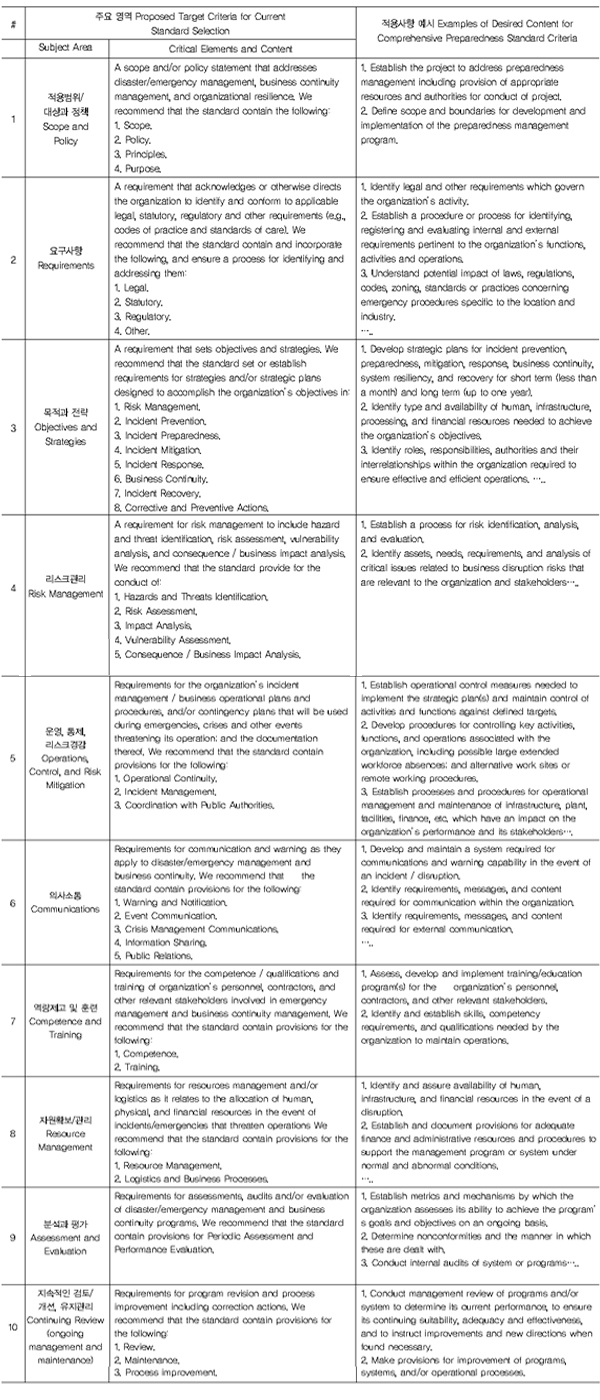끝없던 정쟁과 비방, 패러디, 선거유세, 공약 등이 끝나고 오바마 대통령의 취임과 더불어 1월 새로운 행정부가 들어섰다.
The neverending campaigns, primaries, debates, interviews, parodies, commercials and elections are blessedly over. The electorate (and not the courts) has spoken and we will have a new party in the White House and a large number of new legislators taking office in January. If form holds true, we will most likely have a new Secretary of the Department of Homeland Security.
오바마 신 행정부가 해결해야 하는 이슈들이 많지만 그 중 높은 우선순위에 있어야 하는 것은 역시 테러, 재해, 비상상황에 대비·대응하고 국토방위(Homeland Security)를 위해 항상 준비상태를 유지하는 것(maintaining the state of preparedness)일 것이다.
The issues facing him or her will be numerous and of ever increasing importance to maintaining the state of preparedness for the United States. Identifying and preventing terrorist actsat home and abroad, securing our ports and airports and quite possibly restructuring of DHS including FEMA will be foremost on the list of activities.
오바마 새 행정부는 지금까지 DHS(국토방위성, Department of Homeland Security)와 FEMA(재난관리국, Federal Emergency Management Agency)를 중심으로 진행되고 있는 ‘민간부문 (자발적) 준비 법안(법령 제9조)’의 인증프로그램과 같은 효과적인 시행과 적용을 위한 조치들에 관심과 노력 집중을 요구 받고 있다.
Somewhere amid the many priorities facing the new administration will be how to move forward with the implementation of the “Private Sector Preparedness Act” (PL 110-53 Title IX Section 524). This act requires the Secretary of the Department of Homeland Security to designate an officer to implement the voluntary private sector preparedness accreditation and certification program.
9.11 진상위원회의 시행 권고안이 발효된 후 최초 FEMA에 의해서 진행됐으나 여러 관계기관들과의 협의가 지연됐다.
The first set of actions was accomplished by having FEMA’s designee being appointed to head the initiative. Following this designation, the next deadlines in the Act were clearly spelled out, “Not later than 210 days after the date of enactment of the Implementing Recommendations of the 9/11 Commission Act of 2007 the designated officer shall develop and promote a program to certify the preparedness of private sector entities that voluntarily choose to seek certification under the program; and.. Implement the program.”
미국국가표준협회와 인증원(ANSI-ANAB)에 해당 책임자가 임명돼 빠른 관련 인증프로그램의 수행, 적용을 기대했으나 이 역시 크게 효과를 보고 있지 못하다. 조직, 기업의 재해·재난관리, 비상관리, 비즈니스연속성 역량에 대해 전문성 있게 평가할 수 있는 전문 감사, 평가자(trained and experienced auditors)에 대한 확보, 육성도 선행돼야 할 뿐 아니라 인증프로그램 집행을 위한 해결해야 하는 과제들이 존재하고 있다.
Clearly this has taken substantially longer than anticipated. After 16 months, the major accomplishment was that the designated officer named ANSI-ANAB (American National Standards Institute - ASQ National Accreditation Board) as the sole sourced appointee to establish and oversee the development and implementation of the accreditation and certification requirements for the Voluntary Private Sector Preparedness Accreditation and Certification Program. While ANSI-ANAB has diligently pursued its charter to establish the criteria for “Certification Bodies,” those who will be chartered with the “audit” roles and grant certification, their ability to complete their mission on time is in jeopardy. The ANSI-ANAB committee of experts who are representing various industry, government, standards development organizations and training organizations has met twice and has an imposed deadline of Feb. 14, 2008 to create the core competencies that must be demonstrated by those who will be accredited to perform certification audits. Clearly the need for certification bodies to demonstrate proficiency in emergency/disaster management and business continuity is crucial to establishing credibility in the private sector community. Without having experienced auditors who are trained and experienced in the BCM disciplines the value of the evaluation and accreditation process will be suspect. Therefore it is important that there be clearly defined requirements so that companies will recognize the value of the certification.
미국 내 민간기업의 비즈니스연속성, 재해·재난관리 역량을 제대로 평가할 수 있는 자국 내의 표준, 기준이 없는 상황이며, DHS, ANSI 등 부처간 접근방식 등도 달라 많은 노력들이 있어왔지만 아직 가시적인 성과를 거두지 못하고 있는 상황이다.
But even with well defined and articulated requirements and a process for accrediting certification bodies, there will be little progress made in this effort unless DHS can “ begin supporting the development and updating, as necessary, of voluntary preparedness standards through appropriate organizations that coordinate or facilitate the development and use of voluntary consensus standards and voluntary consensus standards development organizations.” Even the ANSI-ANAB deadline to report out on the certification body requirements is dependent on the identification of the standard(s) by which organizations can be measured. While there has been considerable effort, there has been little information sharing coming from DHS.
2008년 10월2일 DHS에서 보다 구체적이고 가시적인 기준 (아래 역자 주에서 소개한 10가지 subject area)을 제시하면서 민간부문에 대한 법령 제9조의 시행과 인증프로그램에 있어서 지금까지 더뎌왔던 여러 조치들을 가속화하는 계기를 마련한 것은 고무적인 일이며, DHS에서 발표, 담당하고 있는 국가인프라(주요 인프라와 주요 자원, Critical infrastructure and Key Resources (CIKR)) 보호계획(NIPP, National Infrastructure Protection Plan, 2006년)과 연계되고 일관성을 가지고 있어 주목되고 있다.
On Oct. 2, 2008 ANSI-HSSP held its Seventh Plenary Meeting, in Washington, DC .During this meeting DHS revealed a “target” document that outlined the functional requirements for a voluntary preparedness standard. When asked by attendees if DHS was creating a standard, DHS was quick to point out this document was not in itself a standard, but was designed to be “consistent with the direction in Title IX of Public Law 110-53 for consultation on the selection of standards to be adopted into the Voluntary Private Sector Preparedness Program, the Department of Homeland Security (DHS), by the publication of this notice, is initiating discussion on the proposed target criteria for voluntary preparedness standards with its Critical infrastructure and KeyResources (CIKR) partners and other interested private sector industries, businesses, and stakeholders.”
앞에서 언급한 것처럼 국가 표준의 정비, 그리고 이를 기준으로 한 민간부문 기업에 대한 역량 평가, 그리고 인증프로그램의 적용에 대한 논의는 계속돼 왔으며, 이제는 DHS 및 관련 기관(민간, 정부, 제3의 기관 포함)간의 명확한 역할과 책임의 설정과 면밀하고 철두철미한 시행, 적용의 준비, 그리고 이를 통한 가시적이고 실질적인 성과도출이 가장 필요한 시점이다.
Clearly this was a much needed attempt by DHS to elicit comments from interested organizations, standards development organizations, public entities and private corporations. The comments that would be received from these interested parties would then be incorporated into the process of designating a standard or standards that would become the criteria for certification. The process would ideally result in taking the requirements and performing a cross walk against existing standards to ensure a process that would acknowledge established programs. There has been a great deal of talk by representatives of DHS that points to an eleventh hour attempt to complete the process of designating a standard or standards or actually creating some hybrid form, before the end of the 2008. With the standards around the world in a great state of flux, patience and thoroughness should be the order of the day.
[역자주] Voluntary Private Sector Preparedness Accreditation and Certification Program 소개
법령 제9조(타이틀 나인, Title IX)이란 무엇인가?
9.11 진상조사위원회(9.11 commission)의 권고사항이 민간 기업·조직을 대상으로 한 자발적 대비(준비상태)에 대한 표준과 인증프로세스를 제시하고 있는 공법(public law) 110-53로 발전했으며, 2007년 8월에 대통령 승인으로 법안이 통과, 제정됐다. 법령 제9조는 다음의 목적을 가지고 있다. 민간부문에 대한 자문, 권고사항과 가이드 개발, 모범 실천사례 확보, 자발적 표준 활용, 자발적으로 필요에 의해 원하는 민간부문의 준비상태를 인증하는 프로그램의 개발, 인증프로그램의 관리와 구현, 민간부문을 인증 평가하는 역량 제시, 표준 인증에 대한 대비와 적용의 비즈니스적 필요성 제시 등이다.
| |
 |
|
| |
참조자료:
1) Working Paper - Voluntary Private Sector Preparedness Accreditation and Certification Program Proposed Target Criteria for Preparedness Standard (October 1, 2008) : The attached table, a version of which will be included in the Department of Homeland Security’s upcoming Federal Register notice, is a draft list of target criteria that DHS will consider in determining whether a recommended standard is “appropriate” and may be adopted by DHS as part of the new Voluntary Private Sector Preparedness Accreditation and Certification Program. We invite your views on the list.
2) Disaster Recovery Journal Volume 21, Issue 3 (Summer 2008 Issue) What is Organizational Certification? 미국 재해복구저널 2008년 여름호: BCP수립, 권고안·가이드라인 혼재 - BCP 올바른 ‘평가·운영’대안 ‘인증평가체계’(재난포커스) |
|
< 재난포커스 www.di-focus.com >
| |
 |
|
| |
유종기 한국대표
|
|
번역 : 유종기, Deloitte 안진회계법인 기업리스크자문본부 매니저, 영국 BCI(Business Continuity Institute) 한국대표, BS 25999 Technical Expert (registered by BSI)
기고자 : 알 버맨, CBCP, MBCI
Al Berman is a CBCP, MBCI, a NFPA committee member, a member of the NY City Partnership for Security and Risk Management, and the co-chair for the Alfred P. Sloan Foundation. He currently serves as executive director of DRI International. He can be reached at .
|







